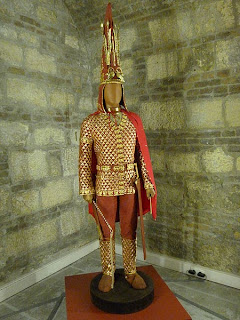From near the the village of Filippovka in the Orenberg region of southern Russia comes news of a recent archaeological find; a previously undisturbed 2,500-year-old grave of a wealthy Sarmatian woman. A news article about this find can be read here.
 |
| Reconstructed costume, Issyk kurgan* |
The untouched nature of this find is shown by the picture of the grave in the article. Sarmatians, like the Scythians who occupied this part of the world before them, liked to decorate their clothing with numerous small gold or sometimes bronze precious-metal plaques. If the grave had been opened in antiquity by a would-be robber, those items would certainly have been taken, instead of being found all about the woman's remains. In addition, other valuables were found, including a silver mirror with a decorated gold handle, a large bronze kettle, and what the article describes as containers for cosmetics. No mention is made of surviving textile fragments, though it's possible that the bronze kettle or other bronze items in the grave may preserve some textile scraps that were not mentioned in the article.
Attempted reconstructions of Sarmatian and Scythian clothing are based on evidence (often from depictions of human figures on jewelry) that those peoples wore simple, long-sleeved tunics and (in the case of men, at least) pants, but decorated them with gold and bronze plaques (which have been found in multiple graves). Sarmatian and Scythian women of rank also wore tall headdresses, similarly adorned. No reconstruction image of the Filippovka grave's inhabitant has yet been published, so far as I am aware. However, the figure on the left, a reconstruction of the costume of a Scythian royal, interred in the Issyk kurgan (grave mound) in Kazakhstan gives a good idea of the type of splendor involved. Interestingly, there is some controversy as to whether the costume depicted in the Issyk reconstruction was worn to the grave by a young woman or a young man.
Since the Filippovka grave was untouched, it seems likely that it will attract greater than average attention from researchers. I look forward to learning what information is extracted from future research of this rich find.
Since the Filippovka grave was untouched, it seems likely that it will attract greater than average attention from researchers. I look forward to learning what information is extracted from future research of this rich find.
* Photograph courtesy of Wikimedia Commons.
No comments:
Post a Comment